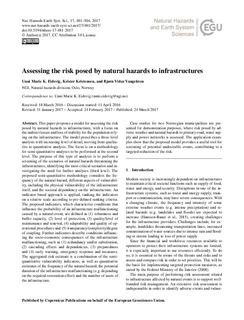| dc.description.abstract | This paper proposes a model for assessing the risk posed by natural hazards to infrastructures, with a focus on the indirect losses and loss of stability for the population relying on the infrastructure. The model prescribes a three-level analysis with increasing level of detail, moving from qualitative to quantitative analysis. The focus is on a methodology for semi-quantitative analyses to be performed at the second level. The purpose of this type of analysis is to perform a screening of the scenarios of natural hazards threatening the infrastructures, identifying the most critical scenarios and investigating the need for further analyses (third level). The proposed semi-quantitative methodology considers the frequency of the natural hazard, different aspects of vulnerability, including the physical vulnerability of the infrastructure itself, and the societal dependency on the infrastructure. An indicator-based approach is applied, ranking the indicators on a relative scale according to pre-defined ranking criteria. The proposed indicators, which characterise conditions that influence the probability of an infrastructure malfunctioning caused by a natural event, are defined as (1) robustness and buffer capacity, (2) level of protection, (3) quality/level of maintenance and renewal, (4) adaptability and quality of operational procedures and (5) transparency/complexity/degree of coupling. Further indicators describe conditions influencing the socio-economic consequences of the infrastructure malfunctioning, such as (1) redundancy and/or substitution, (2) cascading effects and dependencies, (3) preparedness and (4) early warning, emergency response and measures. The aggregated risk estimate is a combination of the semiquantitative vulnerability indicators, as well as quantitative estimates of the frequency of the natural hazard, the potential duration of the infrastructure malfunctioning (e.g. depending on the required restoration effort) and the number of users of the infrastructure. Case studies for two Norwegian municipalities are presented for demonstration purposes, where risk posed by adverse weather and natural hazards to primary road, water supply and power networks is assessed. The application examples show that the proposed model provides a useful tool for screening of potential undesirable events, contributing to a targeted reduction of the risk. | |
